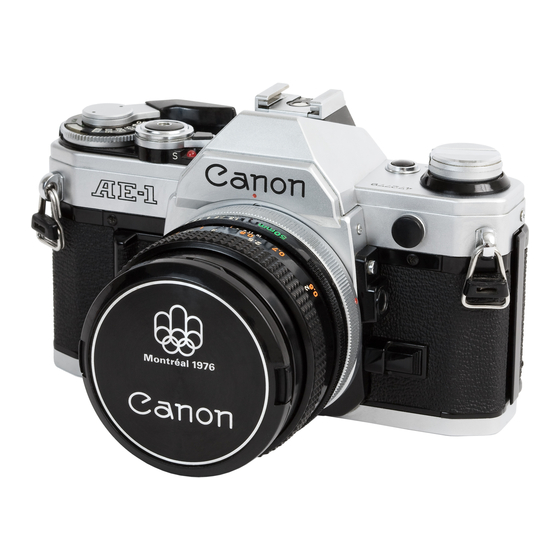Canon AE-1 Manuale - Pagina 17
Sfoglia online o scarica il pdf Manuale per Fotocamera digitale Canon AE-1. Canon AE-1 42.
Anche per Canon AE-1: Come iniziare (2 pagine), Manuale di istruzioni (22 pagine), Manuale delle procedure di installazione (48 pagine), Manuale (12 pagine), Manuale di istruzioni (22 pagine)

needle inside the viewfinder by pressing the shutter button halfway. When the meter needle
inside the viewfinder stays within the proper range and the underexposure warning LED lamp
below the aperture scale inside the viewfinder does not blink, the exposure is correct.
When the underexposure warning lamp inside the viewfinder blinks, or when the meter needle
moves into the upper overexposure warning zone in red, the exposure is incorrect. When this
is the case, turn the shutter speed dial until the meter needle inside the viewfinder moves into
the proper exposure range. To confirm this, turn the shutter speed dial while looking into the
viewfinder and pressing the exposure pre-~ view switch at the same time. It is convenient to
turn the shutter speed dial with your forefinger in order to swiftly cope with the speed of fast
moving subjects. When using shutter speeds slower than 1/30 second, the camera should be
placed on a tripod to avoid the possibility of camera shake.
c) Viewing and Focusing Focusing is performed in the small round area in the center of the
viewfinder. The smaller central circle is a split-image focusing screen and around it is the
microprism ring. The split-image rangefinder ascertains that the image is "in focus" when the
image divided horizontally in half matches and becomes one complete image.
It is also possible to focus with the matte screen outside the smaller central area. You can
focus with either of these focusing aids as you like, depending on the subject condition and
your preference.
Dioptric Adjustment Lenses Dioptric adjustment lenses can be attached by inserting them
from above into the grooves in the viewfinder eyepiece to compensate for the individual
eyesight. With them, near-sighted or far-sighted persons can perform photography without
glasses.
Accessories such as an eyecup, dioptric adjustment lenses, angle finders, and magnifier can be attached to the
viewfinder eyepiece.
One way of selecting the correct dioptric adjustment lens for you is to select the one that is the
closest to your glasses in regard to number of diopters. But, we propose that, when you select
the most appropriate dioptric adjustment lens, you actually look into the viewfinder through it
after placing it over the eyepiece.
Note:
Because the camera itself has -1 diopter, the diopters of the lenses are recorded as the real power when
attached to the camera, thus reflecting the power of the camera's viewfinder.
The microprism rangefinder presents a clear and steady image
when in focus. The microprism conveys a broken, shimmering
image when not accurately in focus.
The built-in eyepiece lens of the AE-1 has -1 diopter. The following 10
kinds of dioptric adjustment lenses are optional accessories: +3, +2, +1.5,
+1, +0.5, 0, - 0.5, -2, - 3, - 4 (diopters).
